Adapt or Get Left Behind: How NRG Reinvented Itself from a Fossil-Fuel Company into a Clean Energy Giant
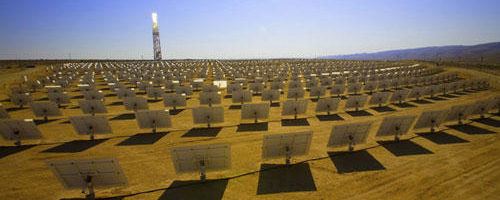
How did a traditional fossil-fuel company reinvent itself as a clean energy giant in less than a decade and shake the rest of the industry out of its complacency? It viewed climate change as an opportunity not a threat.
With the Power Industry at a Crossroads, NRG Goes Renewables
The power industry has been at a crossroads. The slow-moving and non-innovative industry is facing a rapidly changing world because of climate change. New regulations focused on reducing greenhouse gas emissions and tackling climate change are being introduced at the state and federal level.1 Costly requirements for power plants to comply with air and water quality standards have put pressure on or forced many fossil fuel plants out of business.2 A manufacturing glut in Asia is dramatically bringing down the cost of renewables.3 Corporate, commercial and residential customers are becoming more focused on tackling climate change by purchasing clean energy and going “green.”4 While other industry players are doubling down on fossil fuels, NRG Energy is doing things differently.
The largest independent producer of power in the U.S. with over 150 power plants (i.e., 50 GW of total capacity with 45 GW from conventional generation), NRG has become the unlikely champion of clean energy, making a major push in the space over the past decade with over 5 GW of renewable assets including solar PV, solar thermal and wind.5
How did this traditional energy company transform itself, becoming a clean energy giant in less than a decade, and shake the rest of the industry out of complacency? While its competitors have seen climate change as a threat to their existing business because of costly regulations, NRG has viewed it as an unparalleled market opportunity to transform itself, diversify from its existing commodity-driven conventional generation portfolio, and create significant shareholder value.6 The combination of new state renewable requirements, federal stimulus dollars and tax incentives has made investing in clean energy extremely financially attractive.
In its 2010 investor presentation, NRG made its objectives very clear: 6
NRG’s Traditional Operating Model Aligns Well with the Renewable Energy Opportunity
Entering clean energy and investing billions was based on the assumption that NRG’s core operating model developed from its conventional generation experience actually fit well with what is needed to succeed in this space. The operating model did not have to change significantly. It just required some thoughtful refinement to fit new renewable technologies.7
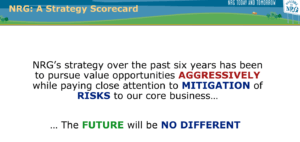
- Long-Term Customer Relationships: The company has strong relationships with its corporate and residential customers who have bought power through the conventional generation and retail businesses. These relationships have been leveraged to sign long-term power purchase agreements for renewable energy projects.
- Financing Advantage: The company’s large balance sheet, strong liquidity and ability to access capital markets for project debt, equity and tax equity has been crucial to financing new renewable energy projects.
- Project Development Expertise: While the development process for a clean energy project certainly has differences from traditional fossil-fuel plants, power plant development is generally the same. NRG has leveraged its past expertise and knowledge to become an expert renewables developer and investor.
- Market Intelligence: Having power plants across the country has been a major competitive advantage. It has provided visibility into deregulated energy markets which assists with the financial underwriting of clean energy projects.8
NRG’s Clean Energy Strategy: Challenges and Opportunities
NRG has made significant progress with this strategy over the past decade. It has created a dedicated renewables business that is one of the industry leaders, entered new sectors via greenfield and acquisition, and has positioned itself as a key partner for large corporates looking to go “green” such as Whole Foods and MGM.9

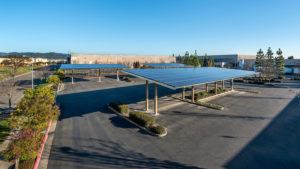 It realizes that clean energy is an attractive asset class and where the growth of the industry lies.
It realizes that clean energy is an attractive asset class and where the growth of the industry lies.
As climate-change driven regulations continue to put more pressure on NRG’s existing coal and gas fleet, the race to diversify and build more renewables is on. A major challenge will be how to satisfy shareholders that invest in NRG for its conventional generation business. Crane was ousted recently by the board, in the opinion of some, because of his significant renewables focus.10 The company’s strategy of investing in renewables while continuing to de-risk its core business might only work for so long with a non-purely “green” investor base. NRG needs to think about its long-term financing strategy to ensure investors will stay with the company on its renewables journey. The reliance on tax incentives which are scheduled to phase off is also a threat. NRG should focus on reducing costs ahead of that drop-off to ensure projects can remain viable.
There is also significant growth in international renewable markets such as South America and India. As climate policy puts pressure on countries to reduce emissions, they are increasingly raising their renewable targets. While NRG is building out its U.S. presence, it needs to also devote resources and allocate capital to foreign markets. Once other companies achieve first-mover advantage, NRG might miss out on the incredible opportunity created abroad by climate change.
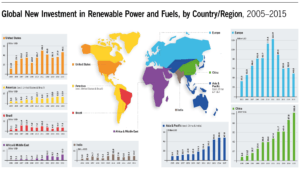
Word Count: 800
Sources
- http://www.nrel.gov/tech_deployment/state_local_governments/basics_portfolio_standards.html; https://www.epa.gov/mats/cleaner-power-plants
- https://www.eia.gov/todayinenergy/detail.php?id=7290
- http://www.bloomberg.com/news/articles/2016-08-23/solar-industry-braces-as-looming-glut-threatens-to-erode-prices
- http://www.pwc.com/us/en/corporate-sustainability-climate-change/publications/corporate-renewable-energy-procurement-survey-findings.html
- http://maps.nrg.com/
- http://phx.corporate-ir.net/External.File?item=UGFyZW50SUQ9NjMxMTd8Q2hpbGRJRD0tMXxUeXBlPTM=&t=1
- http://phx.corporate-ir.net/External.File?t=1&item=VHlwZT0yfFBhcmVudElEPTI1NjAyMjV8Q2hpbGRJRD0zNjAwNzY=
- http://phx.corporate-ir.net/External.File?t=1&item=VHlwZT0yfFBhcmVudElEPTI1NjAyMjV8Q2hpbGRJRD0zNjAxNDE=
- https://cleantechnica.com/2015/02/19/nrg-kaiser-marry-solar-health-interests/
- https://www.greentechmedia.com/articles/read/A-Conversation-with-David-Crane
Multimedia
- SEIA Solar, Google Images for Photos, CNBC Video, NRG Investor Presentations, REN 21 2016 Report.


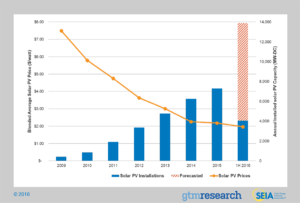


I agree that a significant challenge the company will need to overcome in order to focus its future strategy on renewables is ensuring an alignment with NRG’s investors. After reading your post, I found a Bloomberg article that further discusses the company’s pivot away from renewables after CEO Crane was fired (http://www.bloomberg.com/news/articles/2016-01-13/nrg-s-green-visionary-departure-leaves-clean-energy-questions). According to the article, NRG’s investors were unhappy with the unprofitable performance of the home solar business, thus pushing for a re-focus on conventional generation. This leads me to wonder, as you had mentioned, whether a non-green investor base will serve as a roadblock for the company to build more renewables, even if these projects do end up achieving high returns for them. I think the only viable way that NRG can successfully take on new renewable opportunities both in the US and international markets, would be to re-evaluate and focus on attracting a more green investor base.
Fossil fuel-dominated Energy companies and Utilities are all facing the same challenge than what NRG is facing: How and when to progressively phase out of fossil fuel. As your article mentions, one mistake these companies have to avoid is to misrepresent the company’s core business to investors. NRG’s former CEO also made poor use of its shareholders’ capital when it acquired several solar home businesses, and invested in an EV charging business. Both turning out to be hugely unprofitable ventures (www.nytimes.com/2016/04/24/business/energy-environment/renewable-energy-stumbles-toward-the-future.html). DONG Energy, from Denmark, is an example we could learn from. The company appears to be successfully transitioning from a utility and oil and gas business to an offshore wind business, as its succesful IPO earlier this year can attest (https://www.ft.com/content/6b4638bc-2e20-11e6-a18d-a96ab29e3c95). Dong Energy is now perceived to be a leader in the offshore wind industry, winning tender after tender recently, and driving down cost reduction (https://www.ft.com/content/18b0f2b6-42db-11e6-b22f-79eb4891c97d). The key to its success? It has picked an industry it can dominate and influence, and has shifted the majority of its capital allocation towards that business. It seems investors will always reward an industry winner green or not.
I think the company should diversify into renewable energy, but the firing of Crane leads me to wonder if the company will continue down the same path? I am curious to find out if the company is still making investments into renewable energy. Also, are there truly synergies between renewable energy production and coal energy production; more specifically, what type of capital expenditure is required to facilitate the integration of the renewable energy productions? Also, is there a change in the customer’s expectation since the company is moving from coal to renewable energy; is renewable 100% reliable? Lastly, if the company does decide to switch to renewable, can renewable reliably meet the energy demand of the US (http://www.nrel.gov/analysis/re_futures/)?